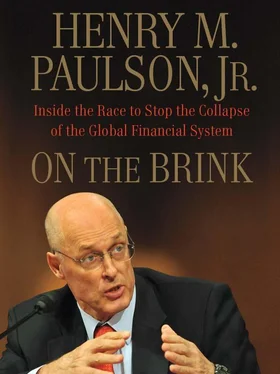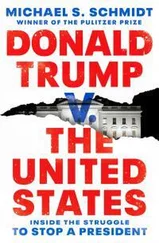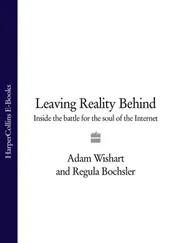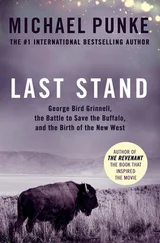Among other things, we proposed a system that created a government responsibility for systemic risk identification and oversight. We recommended strengthening and consolidating safety and soundness regulation to eliminate redundancy and counterproductive regulatory arbitrage. Acknowledging the proliferation of financial products—and the abuses that have accompanied them—we also proposed a separate and distinct business conduct regulator to protect consumers and investors.
There is a well-recognized need for a global accord requiring banks to have higher levels of better-quality capital. This will be more difficult to achieve for some of the more highly leveraged European banks, but consistency here is important, and a stronger capital position will allow the banks to lend more in a downturn, when credit is most needed. Regulators must also require bigger liquidity cushions, and these, too, must be harmonized globally. A simplistic one-size-fits-all model will not work for liquidity. Bank managements and regulators need to have a better understanding of the potential liquidity demands, which will vary bank by bank, under adverse conditions.
With a $60 trillion global economy and a $14 trillion U.S. economy, it is inevitable that we will have a number of very large financial institutions whose increasing size and complexity are driven by customer demands in a global marketplace. Inside the U.S., which still has 8,000 relatively small banks along with its many big institutions, competitive pressures will also force the industry to continue to consolidate. Just as many people shop at Wal-Mart while mourning the disappearance of their local retailers, so, too, will they find their way to bigger commercial banks offering a wider range of lower-cost services and products than smaller banks do. The institutions that are emerging to satisfy all of these needs are complex, difficult to manage and regulate, and pose real risks that must be confronted.
There is no question that tighter, and one trusts better, regulation is coming. I hope and expect that big institutions will be regulated in a way that considers the risks resulting from their size and from acquisitions or new business lines that make them riskier and further complicate the already difficult task of managing them effectively.
However, regulation alone cannot eliminate instability, and we will inevitably be confronted with the failure of another large, complex institution. The challenge is to strengthen market discipline as a tool to force institutions to address problems before they become impossible to solve and to design a means of absorbing a large failure without the entire financial system’s being threatened. As I have said repeatedly, we need more authority to deal with, and wind down, failing institutions that are not banks. The current bankruptcy process is clearly inadequate for large, complex organizations, as the failure of Lehman Brothers demonstrated.
I shudder at the thought of any future administration’s having to cope with another crisis hobbled by the constraints that we faced. For this reason, I favor broad authorities to deal with the failure of a systemically important institution—including the power to inject capital and to make emergency loans. Some critics may say that such powers would only increase the risk of moral hazard, but I am confident that procedural safeguards can be put in place to help manage such concerns and to mitigate market distortions.
Wind-down authority must be constructed to impose real costs on creditors, investors, and the financial franchises themselves so that market discipline can continue to be a constructive force in the regulation of large, complex firms. However wind-down authority is devised, it will affect market practices and credit decisions. To minimize uncertainty in the market, the government should provide clear guidance as to how it would use this enhanced authority. And a very high bar should be set before it is used, similar to the constraints that are placed on the FDIC before it liquidates—or, in technical terms, “resolves”—commercial banks.
The successful management of large, diversified financial institutions also demands the presence of strong, independent risk and control functions as well as compensation policies that do not promote excessive risk taking. Risk management, compliance, control, and audit functions are underappreciated and very difficult jobs that must be considered to be as important as those of the revenue-generating traders within an organization. These risk professionals must hold the upper hand in any dispute. This can only be accomplished if the organization has a culture that respects these essential jobs and demonstrates as much by offering a career track and compensation structure that attracts and keeps outstanding talent.
There is now a recognition that regulators need to work with the financial industry to set pay standards, but this can and should be done without regulators’ determining specific compensation levels. Instead, pay should be aligned with shareholder interests by ensuring that as an employee’s total compensation grows, an increasing amount of it is given out as equity that is deferred—vesting and paying out later—and subject to being clawed back under certain circumstances.
Senior executives should be prevented from selling most, if not all, of the shares they are paid; when they retire or leave, their deferred shares should be paid out on a predetermined schedule and not accelerated. It is critically important that those running financial institutions today recognize the understandable outrage about the costs that have been inflicted by the crisis on the public and the taxpayer. It is incumbent upon these executives to show real restraint in their own compensation as an example of leadership that will strengthen the culture of their firms.
Determining the future of housing policy will be among the most difficult political issues, and it will require a decision on the future of Fannie Mae and Freddie Mac. These institutions, which were at the heart of the U.S. policies that overstimulated housing in the past, cannot stay in conservatorship forever. They remain the primary source of low-cost mortgage financing in the U.S. But as the housing and mortgage markets recover, the Fed’s support for the GSEs will end, and private capital will return. Fannie and Freddie should not then be allowed to revert to their old form, crowding out private competition and putting taxpayers on the hook for failure while shareholders benefit from success.
At a minimum, the GSEs should be restructured to eliminate the systemic risk they posed. An easy way to address this is to shrink them by reducing their investment portfolios—and their huge debt loads. I also believe that their mission should be curtailed significantly to reduce the subsidy for homeownership that helped create the crisis. It is important to leave room for a robust private-sector secondary mortgage market that serves the taxpayer and homeowners equally well.
Realistically, these enormous entities won’t be allowed to simply disappear. Focusing on the function of the GSEs as mortgage credit guarantors, Congress could replace Fannie Mae and Freddie Mac with one or two private-sector entities that would purchase and securitize mortgages with a credit guarantee explicitly backed by the federal government. These entities would be privately owned but set up like public utilities and governed by a rate-setting commission that would establish a targeted rate of return. This approach would address the inherent conflicts between private ownership and public purpose that are unresolved in the current GSE structure.
The stress in this case would come from mortgage originators’ looking for new ways to put risky loans into the pool to get a government-backed guarantee. In this model, safety and soundness regulation would be essential, as would be supervisory oversight to make sure that the quality of conforming loans remained high.
Читать дальше












